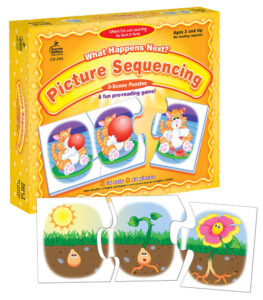What Happens Next? Picture Sequencing

Using games in therapy sessions
What Happens Next? is a great fun activity that can be used by speech & language therapists, occupational therapists, physical therapists, and special education teachers. Games can make therapy fun and engaging for the child while the therapist can elicit responses and actions that meet therapy goals.
What Happens Next? Picture Sequencing
What Happens Next? Picture Sequencing Game from Carson-Dellosa with 14 sets of 3-piece sequence puzzle pictures. The game can be played with one player for ages three and up.
Suggested lesson for What happens Next?
Pre-select the 3-piece puzzle. Take it apart and present the pieces in a jumbled order. For this sample, we will use the “Puppy on the Slide” sequence.
“We’re going to put together a story puzzle. The pictures on the puzzle tell us what happened to each character. Let’s look at the pieces.”
“Tell me what is going on in this piece? Yes, the puppy is at the top of the slide.”
“What is going on in this piece? Yes, the puppy is standing next to the slide and he is wagging his tail.”
“And what is going on in this last piece? Yes, the puppy is sliding down the slide.”
“Let’s put them in an order that makes sense. Would you be at the top or bottom of the slide before you slide down.”
“Yes, you would be at the top. Let’s put those pieces together. They fit together.”
“Let’s look at the last piece. The puppy is at the bottom of the slide wagging his tail. He is happy, he wants to slide down the slide. Let’s fit the piece to the side of the other two pieces. It fits.”
For children who are able to follow those directions, you can add another step. You can incorporate vocabulary cards or articulation cards. If you are working on particular sounds, reinforce the correct placement and production of the sounds.
If the child is more proficient with sound production, have them use the word in a sentence.
Start with a carrier sentence, such as: “I see a puppy.” As they are successful, go to a more complicated sentence, such as: “The puppy likes to ride the slide.”
If the goals are to improve receptive and expressive language, incorporate WH questions about the sequence cards.
Speech & Language Therapy
- Describe what is happening in the puzzle picture
- Describe the place where this is happening
- Talk about what happens first, second, etc
Occupational Therapy
- Use two hands together to manipulate the pieces and put them together
- Reinforce crossing the midline
- Improving finger dexterity
- Improving finger and hand strength
Physical Therapy
- Use two hands together to manipulate the pieces and put them together
- Reinforce crossing the midline
- Improving trunk control
- Improving trunk stability
- Improving balance
Special Education
- Name a word that rhymes with the animal or item on the cards
- Where would you expect to find the animal
- What sound would the animal make
- Reinforce the sequence
